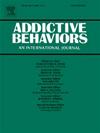Does perceived vaping addiction predict subsequent vaping cessation behaviour among adults who use nicotine vaping products regularly?
IF 3.7
2区 医学
Q1 PSYCHOLOGY, CLINICAL
引用次数: 0
Abstract
Background
This study aimed to investigate whether perceived vaping addiction is a predictor of quitting nicotine vaping product (NVP) use among adults who have ever smoked and currently vape exclusively or predominantly in four countries: Australia, Canada, the US, and England.
Method
Data analysed (n = 574) came from participants (aged 18 + ) who completed the International Tobacco Control (ITC) Four Country Smoking and Vaping survey in 2018 and again in 2020. Baseline inclusion criteria were: (1) currently not smoking or non-daily smoking; and (2) using NVPs daily/weekly for a period of at least 4 months. Association of self-reported baseline levels of perceived vaping addiction with making any attempts to quit vaping and successful attempts reported at follow-up were examined using logistic regression models, controlling for potential sociodemographic and smoking/vaping-related confounders.
Results
Participants who perceived themselves as being addicted to vaping were less likely to attempt to quit vaping than those who perceived themselves as not addicted. Among those who tried, those who perceived themselves being addicted were also less likely to succeed than those who perceived themselves as not addicted. No significant country differences in associations were observed for both outcomes.
Conclusions
Perceived vaping addiction was shown to have predictive utility for vaping cessation behaviours, possibly acting as an indicator of task difficulty, and thus may serve as a useful screening tool for identifying NVP users who may benefit from tailored cessation support programs if they want to stop using these products.
在经常使用尼古丁电子烟产品的成年人中,感知到的电子烟成瘾会预测他们随后的电子烟戒断行为吗?
背景本研究旨在调查四个国家中曾经吸烟但目前只吸食或主要吸食尼古丁的成年人中,感知到的吸食成瘾是否是戒烟尼古丁吸食产品(NVP)使用的预测因素:所分析的数据(n = 574)来自于2018年和2020年完成国际烟草控制(ITC)四国吸烟和吸食电子烟调查的参与者(18岁以上)。基线纳入标准为(1)目前不吸烟或非每天吸烟;(2)每天/每周使用 NVPs 至少 4 个月。在控制了潜在的社会人口学和吸烟/吸烟相关混杂因素的情况下,使用逻辑回归模型研究了自我报告的觉察到的吸烟成瘾基线水平与任何戒烟尝试和随访时报告的成功戒烟尝试之间的关系。在尝试戒烟的人中,认为自己上瘾的人也比认为自己没有上瘾的人更不可能戒烟成功。结论研究表明,认为自己吸食上瘾的人对戒烟行为具有预测作用,可能是任务难度的一个指标,因此可以作为一种有用的筛查工具,用于识别那些希望戒烟的非自愿戒烟者,如果他们想停止使用这些产品,可以从量身定制的戒烟支持计划中获益。
本文章由计算机程序翻译,如有差异,请以英文原文为准。
求助全文
约1分钟内获得全文
求助全文
来源期刊

Addictive behaviors
医学-药物滥用
CiteScore
8.40
自引率
4.50%
发文量
283
审稿时长
46 days
期刊介绍:
Addictive Behaviors is an international peer-reviewed journal publishing high quality human research on addictive behaviors and disorders since 1975. The journal accepts submissions of full-length papers and short communications on substance-related addictions such as the abuse of alcohol, drugs and nicotine, and behavioral addictions involving gambling and technology. We primarily publish behavioral and psychosocial research but our articles span the fields of psychology, sociology, psychiatry, epidemiology, social policy, medicine, pharmacology and neuroscience. While theoretical orientations are diverse, the emphasis of the journal is primarily empirical. That is, sound experimental design combined with valid, reliable assessment and evaluation procedures are a requisite for acceptance. However, innovative and empirically oriented case studies that might encourage new lines of inquiry are accepted as well. Studies that clearly contribute to current knowledge of etiology, prevention, social policy or treatment are given priority. Scholarly commentaries on topical issues, systematic reviews, and mini reviews are encouraged. We especially welcome multimedia papers that incorporate video or audio components to better display methodology or findings.
Studies can also be submitted to Addictive Behaviors? companion title, the open access journal Addictive Behaviors Reports, which has a particular interest in ''non-traditional'', innovative and empirically-oriented research such as negative/null data papers, replication studies, case reports on novel treatments, and cross-cultural research.
 求助内容:
求助内容: 应助结果提醒方式:
应助结果提醒方式:


